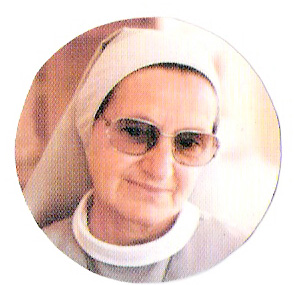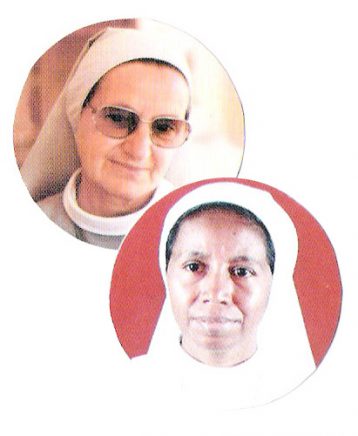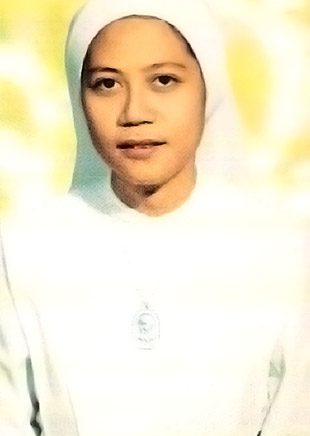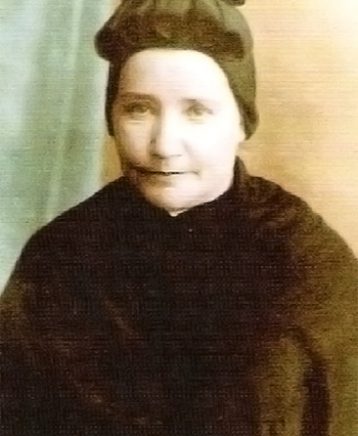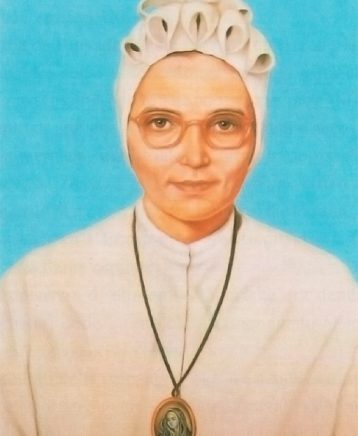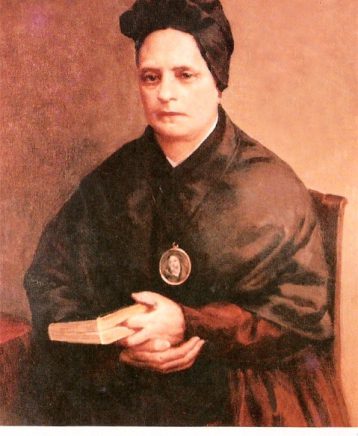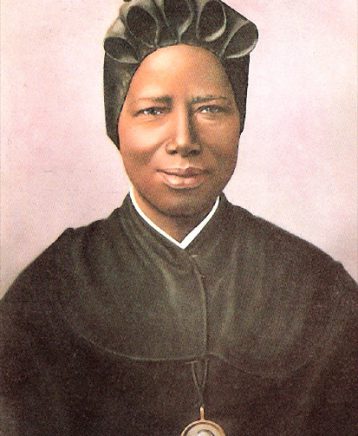Sister Luigia Grassi (1811-1888) - the Servant of God and promotor of canossian mission "ad gentes"
LUIGIA GRASSI, was born in Milan on the 7th of September 1811. Attracted by the love of Christ crucified, she entered the Institute of the Canossian Daughters of Charity, in December 1833.
In the house of Pavia, she made herself a gift for all and she came to be called ?Mother Charity?. In 1860 she opened the doors of the East to the first Canossian Mission.
She died in the odour of sanctity on 11th November 1888.
READ MORE:
THE STRUGGLE OF BEGINNINGS
It was the Foundress Saint Magdalene di Canossa herself who encouraged the Canossian Sisters in Milan to accept into their novitiate the 22 year old Luigina Grassi. So she entered 31.12.1833. Luigia met again the Foundress at the end of the first year in the novitiate, when she had to ask her to be admitted to the clothing of the religious habit. "Do well, dear", was the answer she got from Magdalene. these words became for Luigia, as the seal for the "great enterprise" to which God would call her later.
Sr Luigina's state of health was not strong, yet she concluded happily the preparatory stages prior to her religious profession (15.09.1835). Soon after this she was assigned to teach the hearing impaired, but that experience was short; in fact she was asked to give that up in favour of teaching young country girls preparing to become teachers themselves in their own villages. For Luigina, this change was an early sstart on the road to renunciation and detachment.
AUTORITY AS SERVICE
In 1847, another Community was established in Milan, in Porta Comasina, Luigia was assigned there as the Superior. She accepted that charge as service, putting the whole of herself to organizing, helping, comforting. Under her guidance the Canossian MInisteries bloomed and the Sisters themselves were competing among themselves to help one another.
On March 18 of the following year the revolution termed: "Le Cinque Giornate di Milano" (Milan's Five Days) broke out. The jouse of the Canossian Sisters was soon filled to overflowing with people terrified by the austrian artillery. For the young community this was their testing ground. The Sisters entertook everobody with generosity till the austrian army abandoned the city.
AN INSPIRED TEACHER
In 1850 we find sr Grassi covering the role of Assistant Superior in the Canossian First House in Milan in Via della Chiusa.
The Superior there was sr Margherita Crespi who had had young Luigina as her pupil in school. She has suggested to her to write a whole page with the phrase: "Luigina, the Lord wants you to be a saint!". But at this stage of her life, however, such a glorious thought was more frithening than inspiring.
It was in this new house that Luigia net a genovese missionary asking for help for poor african children. Sr Luigia referred him to Fr Biagio Verri, who later felt inspired to become a missionary himself. Later, he told to sr Grassi: "It was you, reverend Mother, who started me on this road and gave me my missionary vocation".
From then on, sr Grassi got increasingly interested in the missionary problem.
AN "ANGEL" IN NAME AND DEED
In September 1850, Msgr. Angelo Ramazzotti, the founder of the Institute for the Foreign Missions of Milan (P.I.M.E.), was nominated bishop of Pavia. He begged sr Crespi tp send some of her sisters to his new See. After about a year of attempts, a group of Canossians, headed by sr Grassi appointed as their superior by sr Crespi, left Via Chiusa for Pavia and reached Corso Garibaldi, place that had been chosen purposely by the Bishop himself.
On December 30, 1852, the new house was inaugurated. Besides the traditional Canossian MInisteries, the sisters started to give their assistance to the poor girls of the "Pia Casa d'Industria", (Pious Home of Industry). Among these girls, sr Grassi fekt sshe really was "servant of the poor". She was helped by Ramazzotti through the frequent letters. This was of hreat help to the vitality of the Institute as the Sisters were undertaking the MInistry of the Spiritual Exercises and the formation of reliable girls as "country teachers".
PROPHETIC DREAMS
It was during this time that sr Grassi had a mysterious dream. She saw Crist suffering for the infedilities of consecrated persons. She expressed to Him her desire to consoling Him but He answered: "Luigina, it is your turn! It is your turn!". She felt this as a mandate and told herself: "If this entails leaving, come on!".
Later she had another dream. One early morning, as she was waking up, she heard a loud guttural groan as of a hanging person. In her fright she screamed: "What is it? What is it?" The answer came in a terrible voice: "I am the devil who wanted to strangle you!". (Note that sr Grassi was constantly goaded on by her zeal for the salvation of people).
In 1856 the Sisters a Pavia, helped by Commission were aoutsanding both for their authority and their birth. These had to assume the responsability of continuing their assistance to these until they had learn to speak and completed their education.
At this time, a cholera epidemic broke out. A sister caught it while assisting the patients, and thanks also to the trusting prayer of them all, she was miraculously healed. The schools, however, were closed and the enrtance guarded by a sentry. The sisters were very busy nonetheless. They took this as their chance to organize a course of Spiritual Exercises that was very successful. Fr. Cairoli himself had preached the retreat, prior approval of the Bishop. Cairoli had been obliged to remain in the convent on account of stringent health laws.
Vocations to the religious live kept multiplying. Sr Grassi, concerned about their adeguate formation
In the days the cholera raged, sr Grassi had written: "I cannot control my tears, but they dry up fast ... for sure, some great designs is hidden behind them".
NEW HORIZONS
Then she had another vision. It seemed to her she was in a garden. Her thoughts were immersed on God to whom she was aggressing ardent aspirations. Suddenly she saw a very big weeping willow with extraordinarily long drooping branches. Then the branches turned into vine branches bearing precious grapes with berries much larger than normal. At the same time she heard the Lord telling her:?It is in this way that I wanted many people to be saved through you?.
In 1856, the young Emperor Francesco Giuseppe of Austria convened all the Bishops of the States under his regime to see that they implemented to the full the Concordat with the Church. Bishop Ramazzotti too had to partecipate. During his long absence, the corrispondence between sr Luigia Grassi and the Bishop did not slack. She kept him informed on the general situation of the Community and of their ministries. He in turn provided her with his support and advice. In one of his lovely letters that reveals him as a person whose trust in God is complete, he expresses himself thus: ?When the Daughters of Charity, even those in Pavia, will be in heaven surrounded by the great number of souls saved through their charity?I too will share the goodness of the Lord!?. This expression shows the great benevolence the Bishop felt towards the Institute.
In 1858, under the pontificate of Pius IX, with the consent of the Emperor, Bishop Ramazzotti was nominated Patriarch of Venice. For sr Grassi this meant new difficulties both spiritually and financially. This situation, however, was lightened through a Commission of iutstanding people in Pavia. The Commission was headed by the Pavia Capitular Vicar, Vincenzo Gandini. But alas! The new Patriarch took Fr. Cairoli with him.
In 1859, the war spread fear and apprehension everywhere. Sr Grassi asked the Patriarch his mediation in order to avoid the impending dangers. One of these was the risk of having to send the novices home for lack of sustenance. The novices, however, unanimously declared themselves ready to face death rather than dismissal.
DISAPPOINTING ?NO? FOR INDIA
Some missionaries from India sent an appeal to the Patriarch of Venice to have some Sisters. They were to run schools, orphanages, hospitals. Msgr. Ramazzotti informed sr Grassi right away. Some of the Canossian Communities, however, were not of the same mind. Unexpectedly, they strongly opposed the idea. Even the Sacred Congregation for Bishops and Religious did not approve of the Canossian Sisters contemplating sending their members to the Missions. This caused sr Grassi a lot of suffering but she had to give up the idea. The Patriarch, commenting on the situation, wrote to her: ? May God?s will be done: this is the most beautiful Mission assigned to us!?
MEMORABLE ?YES FOR CHINA?
Two missionaries in Hong Kong, had asked monsignor Marinoni to send them six Canossian Sisters. These vere to take chargé of little orphan boys and girls and of the schools for English, Chinese ad Portuguese girls.
Mons. Marinoni found himself, and not for the first time, faced with a lot of difficulties Chief of which was that of having to give a little more breath to the Rules of the Canossian Daughters of Charity. It was again the Patriarch of Venice who smoothed out the problem. In January 12, 1860, Msgr. Ramazzotti presented a petition to the Holy Father Pius IX ?to allow some changes, made necessary by the local situation, to the Rules of the Canossian Daughters of Charity?.
The Holy Father, through Cardinal Barnab?, approved for thes changes and blessed the beginnings of the Canossian Foreign Missions. The rescript bore the same date of the petition.
On the evening of Ferbuary 3, 1860, Monsignor Marinoni brought to the Pavia Community the happy news that everything was ready for the departure. It was to be on the same month it had been planned. Even the Emperor Francesco Giuseppe and his Consort Elizabeth would contribute to the expenses of the journey.
THE DEPARTURE
A group of six sisters: four from Pavia community and two from that of Venice, accompanied by sr Grassi. Reached Verona od February 24, 1860, for a stop over at the tomb of the Foundress.
There, providentially, they met sr Adeodata Mazza who had lived with the Foundress. The Sisters wanted to know from her whether Magdalene would have approved sending sisters to the Missions. Without a shade of hesitation she answered: ?What would she have done? With the heart burning with love for neighbor that she had, not only would she have sent Sisters but would have gone herself. Go, therefore, God calls you, God wants you and may God bless you!?
In Venice the Sisters were given a grand welcome. The Patriarch himself presided the function prepared for the imposition of the Missionary Crucifix to the Sisters and wished them well with these parting words: ?Go! And may you navigate guided by the sail of obedience!?
Among the first missionaries are: from Pavia 27 years old Maria Stella, 34 years old Rachele Tronconi, 29 years old Giuseppina Testera, 22 years old Giovanna Scotti. From Venice: 40 years old Lucia Cupis and 20 years old novice Claudia Compagnotti.
BREAKING THE ICE IN HONG KONG
The first news from Hong Kong was comforting. The sisters were telling of the baptism of a Chinese girl and the vocation of Aloysia Browing, the ex - Governor?s daughter. Aloysia, whe came from a Protestant background, embraced the Catholic faith and later joined the Canossian Sisters. She went on to became a fervent novice and then an exemplary religious.
Soon sr Grassi was asked reinforcements. She turned alsto to the others Canossian Communities, so between the years 1861-1862 five Sisters from the communities of Verona, Venice and Legnanello left for Hong Kong. Hong Kong became the new sendind Center. From there, other foundations in the interior of China and India became a reality.
FESTIVE BELLS IN HEAVEN
On September 24, 1861 Msgr. Ramazzotti died. His death left sr Grassi filled with sorrow and preoccupations. She, hovever, trusted a lot in his protection from Heaven. After all the Pavia community was the one that he ?loved with a Father?s love?.
He building housing the Pavia community belonged to the Ramazzotti family. Soon the people came to know that the Canossian Sisters had inherited the whole building complex. But what the people did not know was that Msgr. Ramazzotti, due to the great amount of charity he had done, was left with no money to provide the three quarters needed for the total payment of the building. The Sister?s dilema was what to do: renounce the inheritance?
When some pious persons became aware of the situation, they came to the Sisters? help. In a year the whole property came into the possession of the Canossian Daughters of Charity and this affair too was brought to a happy end. The benefactors themselves admired the correct behaviour of sr Grassi even in this circumstance.
The House was termed ?Canossian Institute for Foreign Missions?.
Novembre 21, 1872: the sixth expedition for China of the Sisters from Pavia. Equally also in 1874. In that year an another community was established in Pavia, at al Senatore.
In the meantime, the proces for recognizing the heroism of Magdalene of Canossa?s virtuse had been opened.
UN UNFULFILLED DESIRE
In 1876 a sister, broken by sickness returned from the mission, sr Grassi manifested her desire to take her place in this mission. But the Bishop?s answer was: ?You must remain rehe to ring the bell calling more young missionaries, and to show them the way?. She pbeyed and remain tranquil. She increasingly acquired dtrength as she saw her mandate taking shape: to prepare the way, to call together generous young ladies who, once robust in their faith, could see the path to follow and take it in their stride to the end.
NOVITIATE IN PAVIA
On October 20, 1879, after some contrasts, Msgr. Ribolti, authorized by Msgr. Luigi Canossa, Bishop of Verona, erected canonically the Canossian Novitiate for Foreign Missions, with residence in Pavia.
Sr Grassi?s enterprise had reached its consolidation. It was the triumph of her faith, of her humility, her silent suffering in the slow maturation of that blessed phrase ?It is your turn!?. She would find peace only in her generous answer to that ?Do well, dear!?.
Following the canonical erection of the Novitiate, vocations became more numerous so that on February 9, 1881, eight new missionaries left for China.
Institute for Foreign Missions had also, besides the communities in Hong Kong and the interior of China,
other communities which to provide. Han Kow, Macao, Timor.
In 1884, five more sisters left from Italy. For of them vere from Pavia itself, prepared by sr Grassi.
THE MISSION in ROME and in PHILADELPHIA
In Octobre 15,1885 sr Grassi accompagny to Roma four Sisters, because Msgr. Parocchi, elected Vicar if the Holy Father for the Diocese of Rome, with his strong desirehe worked and obtained, with the Pope?s approval, that the Canossian Sisters establish themselves in Rome.
Another new enterprise appeared on the horizon. A Pastor of Philadelphia (U.S.A.) asked the Canossian sisters to carry out their apostolate among the many Italians living in his Parish territory. Soon the 15-th spedition left Pavia. The foundation, though, did not turn out well. After only a year, ?not wanting and not having the authority to go against the Rule, and being ready to be cut off from their superiors, the five religious, although broken hearted, had to abandon the field and return to Italy?. Sr Grassi suffered greatly for this failure, but her fidelity to the Rule was beyond discussion, and her serene adhesion to the decision of her superiors were equally a succes in God?s eyes. She sent soon after (August 27, 1886) another good number of sisters to China. She called this ?a holy revenge?.
THE LIVE ACCOMPLISHED
On Novembre 10, 1888 sr Grassi fell victim of an ictus. One day later, on Novembre 11, 1888, at 20.00hrs, in the age of 77 years she died. Three days later Bishop Ribolti officiates at the Pontifical Funeral Mass. The participation of such a numerous a number of persons from every category was impressive.
MOTHER LUIGIA GRASSI ? A LIVING MEMORY
The zeal of sr Luigia Grassi was tireless. Her apostolate both in Italy and in the mission lands integrated beautifully.
She died surrounded by a halo of holiness.
On February 24, 1994 the Bishop of Pavia, Mons. Giovanni Volta, opened the Diocesan Inquest for the Cause of Canonization of the servant of God, Sr Luigia Grassi.
From 1860 to the year of her death (1888) sr Luigia Grassi organizz?ed about sixteen expeditions of Sisters in the Mission.
A total numer of them is 258 Sisters left from Pavia between 1860 and 1936, without calculate those who left from another Canossian communities.
Sr Grassi realizzed also the other foundations, in Pavia, in Bologne, in Rome and, in the end, in Belgioioso.
